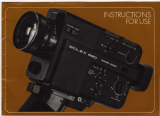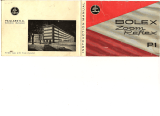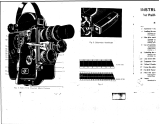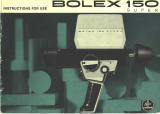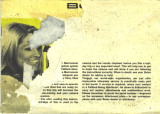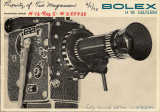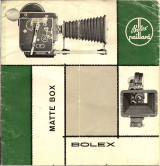Page is loading ...


Your camera is supplied with:
1 sunshade (thread: M 55 x 0.75 mm)
1 rubber eyecup
1 lens cover
1flexible cable release with locking
crown
1 shoulder-strap
1 key for retracting conversion filter
1 grey filter (4 times)
1flash-shoe
1 cap for the conversion filter
retraction slot
Note
We strongly recommend that you
film at least one cartridge and
examine the results before leaving
on a trip or filming an important
event. This will help you to get
acquainted with the camera and, if in
doubt, give you the opportunity to see
your Bolex dealer for advice or help.
Contents
Page
Adjusting the eyepiece.
Inserting the batteries.
Checking the batteries . . . . .
Use of accumulators and accumulator charger.
Loading the camera
Unloading the camera.
Filming speeds
Methods of operation .
Filming with remote-control cable
Electronic running control
ActionLight
®
Footage counter .
Framing the subject
Focusing
Fixed focus setting
Depth of field
Automatic exposure system.
Modification of the time of reaction of the diaphragm
Manual correction of the aperture
Locking the diaphragm
Fade-ins and fade-outs
Filming in daylight and artificial light.
Synchro-flash/synchro-sound socket
Macro shots .
Care of camera
Accessories available on request . .
A few tips enabling you to add interest and life to your movies.
Depth of field charts .
2
2
4
4
5
5
5
6
7
8
8
8
9
10
10
11
11
12
12
13
14
15
15
16
17
18
20
22

Get to know your camera
Your camera has been designed to
take Super 8 films in Kodak 50 ft.
cartridges.
2
1 Lens cover
2 Grey filter (4 times)
3 Bolex Macrozoom® lens 7-56 mm
f/1.8
4 Distance setting ring
5 Manual zoom knob
6 Camera release
7 Switch bar for connecting
batteries
8 Key for retracting conversion filter
9 ActionLight ® switch
10 Rocker switch for power zooming
11 Battery test button
12 Preselection button for dissolves
13 Start key for dissolves
J

25
~~'
----------------------------~~~
14 Sunshade
15 Macro button
16 Power-zoom speed selector
(2 speeds)
17 Tripod bushing
18 Battery housing locking screw
19 Film speed selector (18, 24 or
40 frames per second)
20 Sliding cover over flexible cable
release socket for normal running
and single-frame operation
21 Aperture override control
22 Lid lock
23 Adjustable footage counter, with
disk for marking footage on
inside of lid
24 Shoulder-strap
25 Flexible cable release

26 Finder eyepiece with rubber
eyecup
27 Film plane
28 Cap for lamp-holding or key slot
29 Flash-shoe
30 ActionLight®
31 Cable release socket for
diaphragm lock
32 Remote-control cable socket"
33 Accumulator recharging socket"
34 Synchro-flash/synchro-sound
socket
• available as accessories

Adjusting the reflex finder eyepiece
2
Inserting the batteries
(five 1.5 V cells)
For accurate focusing with the split
image rangefinder, the eyepiece must
be adjusted to your eyesight
(+
3 to
- 3 diopters).
Proceed as following:
Set the zoom knob to the longest
focal length (56 mm).
Open the lid by pressing the locking
button.
Unscrew the finder eyepiece
anticlockwise.
Now there are two possibilities:
1. Set the focusing ring to infinity
(00).
Look at a subject with a prominent
vertical line at least 500 ft. away
(telegraph pole, TV antenna, wall)
and while viewing, turn the finder
eyepiece clockwise until this vertical
line appears continuous (not broken)
across the dividing line of the split
image field.
2. Set the focusing ring to 7'. Place
the camera at a distance of exactly 7'
(measured from the film plane) from
a subject with vertical lines (door or
window frame) and set the finder eye-
piece as indicated above.
Eyecup
The eyecup can be set to any
position; therefore viewing with right
or left eye is possible.
We recommend the use of alkaline-
manganese batteries, such as
MALLORY Mn 1500, EVEREADY E91,
RAY-O-VAC 815, RCA VS 1334, etc.
These batteries deliver more power
and last longer.
If you use ordinary batteries, select
leak-proof ones only, Any damage
caused by leakage of the electrolyte
inside the camera is not covered by
our guarantee.
A set of new alkaline batteries pro-
vides sufficient power for filming
over twenty 50 ft. cartridges under
normal conditions of use.
Battery power drops sharply at low
temperatures.
As a general rule, it is best to change
batteries once a year, even if the
above-mentioned number of cart-
ridges has not been filmed.

Release the screw in the base of the
hand grip.
Pull off the top half of the hand grip
and remove the battery container.
Unscrew the lid retaining screw and
remove the lid.
Insert five batteries in correct posi-
tion: the
+
pole of each battery must
be next to a
+
sign on the container.
Close the container by replacing the
lid and tightening the screw.
Insert the battery container in the
hand grip so that the three contact
points at one side of the container
are in contact with the springs inside
the hand grip. Replace the top cover
of the hand grip and tighten the
locking screw.
3
- - - - ----------------

Checking the batteries
(available as accessories)
Use of accumulators and an accumulator charger
Before using your camera,
.t
is im-
portant always to check the condition
of the batteries.
Hold the camera by the hand grip and
press on the switch bar connecting
the batteries.
Press on the button marked «batt»:
when the batteries are in good work-
ing order, a red light appears in the
viewfinder; if the red signal does not
appear, the batteries need changing.
4
Instead of the manganese alkaline
batteries referred to so far, your
camera may be equipped with SAFT
Ni-Cd VR 0.5 AA or Varta Ni-Cd DEAC
451 RS type accumulators. These
accumulators are inserted in exactly
the same way as ordinary batteries.
They can be recharged about 1000
times; at
14°
F, they are capable of
filming over ten 50
ft.
cartridges in
quick succession. They are recharg-
ed while still in the camera, by means
of a charger plugged into the socket
provided for the purpose; two
chargers are available:
• Bolex charger for plugging into the
mains (110-250 V,,-, /50-60 cycles)
• Bolex charger for plugging into the
cigarette lighter on your car (12 V)
(See illustration page 18)

Loading the camera
Open the camera lid by pressing on
the locking button.
Insert the film cartridge (label to the
right). A notch on the cartridge auto-
matically sets the exposure system to
the speed of the film inserted. This
system works with films of speeds of
40
to
1-60
ASA
(17
to
23
DIN) for arti-
ficiallight, and
25
to
100
ASA
(15
to
21
DIN) for. daylight.
N.B.: If you use
200
ASA
(24
DIN)
film, set the aperture override control
to -';' (see page
12).
Close the camera lid.
Unloading the camera
Hold the camera with the back
downwards.
Press the locking button to make the
lid open and the cartridge slide out.
If the film is completely exposed, the
lettering «EXPOSED" must be visible
in the film gate of the cartridge.
Filming speeds
Using the filming speed selector
located underneath the camera, you
can set the filming speed to 18,
24
or
40
frames per second.
18 frames per second is the normal
speed for amateur filming.
24
frames per second is used for
slow motion effects, panning or shots
taken from a moving vehicle; it is
also used for obtaining the best qua-
lity of sound when magnetic sound is
to be added subsequently to the film.
5

A speed of 40 frames per second
when projected at the normal rate of
18 frames per second gives a very
slow motion effect. This slow motion
is extremely useful for analysing
rapid movements or, from a purely
aesthetic point of view, for showing
the beauty of certain gestures.
It should be noted that the exposure
system automatically compensates
for the difference in light received by
the film when changing from one
speed to another.
6
You can work your camera in normal,
continuous and single-frame opera-
tion.
Normal operation
*
Hold the hand grip so as to press
firmly against the switch bar on the
back: in this way you connect up the
batteries to the motor and the auto-
matic exposure system, and at the
same time allow access to the two
sockets (A) and (B).
You can now operate the mechanism,
either by pressing on the release
trigger or by using the flexible cable
release supplied with the camera,
which you will first of all have to screw
into the socket (A).
Before using the flexible cable re-
lease, in normal operation, you must
push the small crown in and turn in a
clockwise direction.
N.B.: Between two sequences, avoid
pressing on the hand grip and do not
forget to remove the cable release:
this enables the switch bar to return
to its initial position, and the batteries
are then disconnected, which helps
prolong their life.
Continuous operation *
To set the camera to continuous
operation, screw the flexible cable
release as above into socket (A), but
this time turn its small crown in an
anti-clockwise direction: when you
press on the end, the cable release
automatically locks in position: to
unlock it, press on the small crown.

Filming with remote-control cable
This method of operation is used, for
example, if you want to include your-
self in the picture.
Single-frame filming *
Here too, you will use the flexible
cable release, but this time you must
screw it into socket (8). This method
of operation allows you to make titles
and animated cartoons, time-lapse
sequences, etc.; for this, the camera
must be placed on a tripod or a
steady support so as to avoid any risk
of accidental movement, and the
filming speed selector must be set to
18 frames per second. Keep the cable
release slightly bent so as to avoid
any risk of jerking the camera.
*
N.B.: If you film without looking
through the viewfinder, for example
when the camera is mounted on a tri-
pod, you must cover the eyepiece
with your hand to avoid any stray
light getting in and fogging the film.
(available as accessory) (see previous chapter); the camera
will not start yet;
you can now set the camera in mo-
tion by means of the remote-control
cable switch.
You can operate the mechanism of
your camera by means of a remote-
control cable (length 20 ft.). This cable
is particularly useful, for example, for
self-filming, filming animals, etc.
Proceed as follows:
screw the camera onto a tripod;
insert the remote-control cable into
the socket provided for the purpose;
the cable switch must be in the open
position;
with the flexible cable release, set the
camera to ••Continuous operation»
Remarks
a) At the end of a scene, the shutter
may stop in the open position; if this
should happen the last frame of the
scene will be fogged and must be cut
out.
b) Do not forget that when you film
without looking through the view-
finder you must cover up the eye-
piece to avoid any admission of stray
light that might fog the film.
7

Electronic running control
If a red light appears in the view-
finder during filming, this may mean:
that the camera is not loaded (no
film);
that the film is finished;
that the film is not being moved for-
ward; it may, for example, be jammed
in the cartridge: if this is so, take out
the cartridge, and push the film a few
perforations forward by hand; put
the cartridge back in the camera: the
film should advance without trouble.
N.B.: Before opening the camera lid
do not forget to note the length of film
still unexposed. Jot this figure down
on the disk situated on the inside of
the lid (see «Footage counter»).
8
ActionLight ®
In some cases, especially when film-
ing synchro-sound, it is advantageous
for the actors to know when the cam-
era goes into action. This is accom-
plished with an action light located on
the front of the camera, above the
lens. It lights up as soon as the cam-
era starts filming. This lamp can be
disconnected by means of a switch.
Footage counter
The footage counter, which indicates
the length of film left unexposed in
the cartridge, is visible in a window
situated at the back of the camera
(length in feet on the right, in metres
on the left).
If a red light appears in the view-
finder, this indicates that the end of
the film has been reached, whether
or not the counter has reached «0".
The counter automatically returns to
the starting position (15 m / 50 ft)
every time the lid of the camera is
opened.
If necessary, you can unload your
camera even if the cartridge is not
fully exposed: only the visible part of
the film will be fogged. Before open-
ing the camera lid do not forget to

note the length of film still unexpos-
ed. Jot this figure down on the disk
situated on the inside of the lid.
When you wish to continue filming,
proceed as follows:
press on the lid locking button to
release the footage counter adjusting
knob;
by means of this knob, set the foot-
age counter to the figure marked on
the disk;
release the lid locking button: this
locks the footage counter adjusting
knob.
Framing the subject
The focal length of the zoom lens
can be set anywhere between 7 and
56
mm, wherever the lens covers
exactly the desired area. This can be
done manually or with the power
zoom motor.
Manual setting
Turn the zoom knob forward or back.
Power zoom
Hold the camera grip so that the
switch bar is fully depressed.
Depress the front or rear of the power
zooming switch:
T
==
telephoto, W
==
wide-angle.
You can select the zooming speed:
• slow speed; : fast speed.
Zooming
The focal length can also be chang-
ed during filming for zoom effects
which give the impression of moving
towards or away from the subject.
Power zooming produces smooth and
continuous zoom effects, even with
handheld cameras.
By depressing the macro button, the
zoom knob can be turned into the
macro range either manually or with
the motor (see page 16).
9

Focusing Fixed focus setting
Always focus with the lens set to the
longest focal length (56 mm).
Look for a prominent vertical line in
the subject and turn the focusing ring
until this vertical line appears conti-
nuous (without being broken) across
the dividing line of the split image
field.
When focused, the lens can be set at
any focal length and the image will
stay in focus (as long as the actual
subject distance remains constant).
10
Should the vertical line become
slightly broken when zooming to-
wards the wide angle, do not try to
re-focus. This is caused by the design
of the optical system and has no
practical significance.
If one half of the split image field
appears unsharp or darker, move the
camera slightly sideways or up and
down in front of the eye until both
halves of the field appear equally
bright.
For instant readiness the focusi~g
ring can be set to the
markczz
bet-
ween 10 and 13 feet and the zoom
knob to 12. This combination pro-
vides a sharp image from about 6';'
feet to infinity, even in relatively poor
light.

Depth of field
Automatic exposure system
The depth of field is the zone of
sharp focus and depends on the focal
length, the lens aperture and the
focusing distance.
Depth of field is shallow when lens
is set at: .
a) long focal lengths (towards
56
mm)
b) large apertures (towards f/1.8)
c) short distances.
Depth of field is large when lens is
set at:
a) short focal lengths (towards
7
mm)
b) small apertures (towards f/22)
c) long distances.
Consult the depth of field charts in
this instruction manual.
The diaphragm opens and closes
fully automatically, controlled by a
photo resistance fed by the motor
batteries.
The light is measured through the
lens taking into account the sensitiv-
ity (ASA speed) of the film by means
of a special notch in the film cartridge.
For films of 200 ASA (24 DIN), the
aperture correction switch is set to
-'12
(see page 12).
A
glance in the viewfinder shows
whether the light is not sufficient or
too bright for filming.
a) The light is just good enough for
filming, but if the red zone becomes
any larger than on our illustration,
your film will be under-exposed. The
dividing line between the red zone
and the colorless zone corresponds
to an f/1.8 aperture.
N.B.: When filming outdoors at night
(illuminations, fireworks, neon or
electric signs, etc.) you can still ob-
tain excellent results even if the red
zone becomes larger than on our
illustration.
b) The light is very bright but still
suitable for filming; however, if the
red zone becomes any larger than
on our illustration, your film will be
over-exposed. The dividing line bet-
ween the red zone and the colorless
zone corresponds to an f/22 aperture.
11

Modification
of the diaphragm reaction time Deliberate aperture correction
Remarks:
1. When filming in snow, by the sea-
side or against the light, with a color
film of a sensitivity equal to or less
than 40 ASA (17 DIN), you can film
even if the red zone becomes larger
than on our illustration;
2. The grey filter supplied with your
camera is to be used only if you are
using a film of a sensitivity greater
than 100 ASA (21 DIN), or when you
wish to reduce the aperture by two
stops, in order to make dissolves (see
page 14) or to reduce the depth of
field (see page 11).
12
When you push the preselection but-
ton for dissolves (see page 14) to the
position «on", the automatic dia-
phragm setting device reacts much
more slowly than usual; in this way,
you can avoid too rapid and too fre-
quent fluctuations in exposure, when
filming certain types of scenes (shots
of road traffic, panoramic views of
subjects with violent contrasts of
lighting, etc.).
..--
n, +
1 • • •
-1
.-,
....
By means of a sliding switch in the
base of the camera, deliberate over-
and underexposures can be made
without eliminating the automatic
diaphragm control.
By pressing the red locking button,
the switch' can be moved to
"+
1" or
"-1",
or to intermediate positions
corresponding to
"+
'12"
or "-
'12".
At the
+
1 setting the diaphragm is
opened by one stop which is useful
for backlighted shots, portraits
against large bright areas.
At the - 1 setting the diaphragm is
Closed down by one stop to reduce
exposure (for shots from a dark door-
way, for instance).

Important:
Return the aperture correction button
to its center position.
The diaphragm locking system
The diaphragm locking system per-
mits setting the aperture to provide
correct exposure for a certain sub-
ject area within a scene. This is help-
ful in scenes with great contrast - a
person in front of a bright back-
ground, a spotlighted performer on a
dark stage, for instance.
If the meter is used normally and
automatically in such cases, the dark
or bright background area influences
the diaphragm setting, thereby under-
or overexposing the main subject.
The diaphragm locking system can
be used to overcome exposure pro-
blems in such cases.
Using the diaphragm locking system,
perfect exposure can be obtained as
follows:
a) Screw the cable release in the
socket for diaphragm lock.
b) Zoom in so that the view through
the finder shows the main subject
only (no background area).
c) After having turned the little crown
anti-clockwise, lock the diaphragm
in set position with the cable release
lock.
d) With the diaphragm locked, zoom
back to cover the desired area and
film.
e) At the end of the exposure, un-
screw the..cable release.
N.B.: By turning the camera towards
a more or less luminous zone as de-
sired, you can lock the diaphragm at
any setting you wish, which is equi-
valent to manual setting of the
diaphragm.
13

Fade-ins and fade-outs
A B
Fade out: a gradual darkening at the
end of the scene to indicate a change
of time or location.
Fade-in: a film that starts suddenly
with a title or a bright scene does not
look as pleasant and professional as
one that gradually changes from dark
to light by a fade-in.
If two scenes of greatly different
brightness follow each other, end one
with a fade-out, start the other with a
fade-in. The change in brightness is
then less objectionable. The total
length of fade-out and fade-in should
not exceed 4 seconds.
14
Your camera allows you to make
fade-outs and fade-ins by slowly clos-
ing and opening the diaphragm.
These dissolves naturally can only be
obtained if the diaphragm is not al-
ready closed down too far. The maxi-
mum effect is achieved when the
aperture is f/5.6 or larger (i.e. f/4-
f/2.8 - etc.). If the diaphragm is clos-
ed too far (f/8 - f/11 - f/16), you can use
the neutral grey filter supplied with
the camera: this opens the diaphragm
two stops more without affecting the
exposure or color.
At an aperture of f/5.6, the length of a
dissolve is about two seconds, when
the projection speed and the filming
speed are identical.
To make a fade-out:
check the diaphragm aperture and, if
necessary, place the grey filter on
the lens;
push preselection button(A) to posi-
tion «on»;
film normally and, at the end of the
sequence, press on the «start" key
(8) until the diaphragm scale is at
the end of its run (red zone), and then
immediately let go of the release;
release the «start" key
(8);
do not forget to reset the preselection
button
(A)
to «off".

Filming
in daylight and artificial light
Synchro-flashl
synchro-sound socket
To make a fade-in:
check the diaphragm aperture and,
if necessary, place the grey filter on
the lens;
set the preselection button "A" to
«on»;
look through the viewfinder, press
the start key (B) until the diaphragm
scale is at the end of its run (red
zone);
press on the release and, at the same
time, let go of the" start" key (B);
the diaphragm opens slowly until it is
at the working aperture, and you can
continue to film normally;
after completing the sequence, do
not forget to reset the preselection
button "A" to "off".
The
camera is equipped with a con-
version filter which is normally in
position and the camera therefore
set for filming in dayliqb]. For indoor
filming, the movielight can be mount-
ed on the camera by inserting the
base of the lamp into the slot on the
camera. This moves the conversion
filter out of position, thereby assuring
good color rendition in artificial
light scenes. If artificial light scenes
are made without the light mounted
on the camera, insert the key, sup-
plied with the camera, into the slot to
assure proper position of the filter.
Remove the key for daylight scenes.
The same socket can be used for
synchronizing an electronic flash or
for connecting up a tape-recorder.
Filming with electronic flash
By single-frame filming with an elec-
tronic flash plugged into the socket
provided for the purpose, you can
film poorly lighted static subjects, ob-
tain time-lapse effects (growth of a
flower, for example), etc,
The possibilities open to you depend
to a large extent on the electronic
15

Macro shots
flash you use (number of flashes
between two recharges, strength of
flash, etc.). Do not forget that a scene
lasting only 5 seconds on projection
requires 90 frames at the rate of
18 frames/second.
Take the following precautions:
mount the camera on a steady sup-
port (tripod);
determine the correct aperture based
on the electronic flash unit and its
distance from the subject by means
. of the following formula:
diaphragm
=
guide number
distance in feet
Example: guide number 80
distance 10ft.
~ =
f/8
10
Lock the diaphragm at the aperture
determined by the formula.
N.B.: since the optical system in Su-
per 8 cameras has a greater light loss
than in still cameras, it is recom-
mended to use a film sensitivity half
the rated speed (ASA 20 instead of 40)
when determining the guide number.
16
To mount the electronic flash on the
camera, use the flash-shoe provided
for this purpose, which slides into the
slot located on top of the camera and
intended above all for holding the
key for retracting the conversion filter.
We recommend you to make a few
test runs before filming an important
sequence with electronic flash for the
first time.
Synchro-sound filming
The contact used for the synchroni-
zation of an electronic flash gives off
one impulse per frame and can also
be used for connecting a tape-re-
corder for synchro-sound recording.
Your photographic dealer will gladly
give you information concerning the
different possibilities.
r
I
I
I
.--.......
'1/
10
12
14
I
8
18
7\
<
25 1,
5~)'
macro
/
!
/
~
After pressing the macro button, the
zoom knob can be turned either by
hand or with the power zoom motor
into the macro range, thereby extend-
ing the focusing range from infinity
down to where the lens touches the
subject, covering an area approxi-
mately an inch in size.
When the zoom knob is in the Macro
zone, the lens is set to wide-angle
position, which ensures greater depth
of field and good picture steadiness
even if you film holding the camera
in your hand.
/
